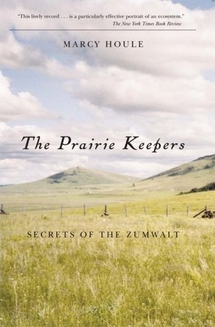Reviewed by Grant McCreary on August 17th, 2009.
The Zumwalt is large, isolated prairie in northeast Oregon. It was known that this region held a large concentration of breeding grassland hawks – Red-tailed, Ferruginous, and Swainson’s. But no one knew why. These hawks, especially the latter two, are declining, partly due to habitat loss and degradation on their breeding grounds. Finding out why they were so successful on the Zumwalt could yield results that would be used to help them in the rest of their range.
Marcy Houle, a graduate student, was chosen to survey the hawks of the Zumwalt and determine their reproductive success. And if, indeed, their density and reproduction were higher than average, she was to attempt to discover why. This was an exciting opportunity, but Houle quickly discovered that it was easier said than done. She was relatively inexperienced and working alone in a huge territory. Not only did she have a lot of ground to cover, it was privately owned, mostly by independent local ranchers. Compounding this, she needed the cooperation of many disparate individuals and government agencies, most of whom despised each other.
During the course of this book, the author relates her experiences from that summer spent studying the Zumwalt. These consist of two separate, but intertwined, threads. The main one focuses on her task. This reads as a sort of ornithological mystery – just why are there so many hawks here? We follow along as Houle surveys the land for hawk nests and then returns to band the nestling raptors. The data confirms the impression that there are an amazing number of raptors in this area. But this is surprising, because the Zumwalt is privately owned and managed for the grazing of livestock. And everyone “knew” that private ranchland and wildlife were incompatible. But as the author continues her study, she finds evidence to the contrary. Is she right? And if so, would anyone believe her?
The second thread is more personal in nature. It follows the interpersonal relationships the author formed with those in the Zumwalt, from ranchers to government employees she had to work with. Unsurprisingly, I found the scientific and bird-related storyline more compelling. But the surprising thing is that it was a close race; I enjoyed the other much more than I thought I would. Much of this has to do with the characters involved. There’s a Don Juan, a misogynist, and ranchers that don’t fit the image that many environmental-types have of them. And the author is quite an interesting character herself.
Through the course of the writer’s study of the hawks, she shares some information about them with the reader. This includes some natural history details, of course, but even more interestingly, you get a look at their personality. Not that I would have anyway, but after reading this, I know that I will never approach a Ferruginous Hawk nest. Houle escaped unscathed, but the same can’t be said of a Coyote that she observed trying to make a meal of some nestlings. The adult hawks had been unable to deter the animal from advancing along the cliff on which the nest was situated. But at the very last second, as the Coyote was about to pounce, the female hawk struck it at full velocity, sending it through the air right over the edge of the cliff.
But even more so than the birds, it’s the Zumwalt and its human inhabitants about which you learn the most. Seeing how this land is cared for, not by conservation societies or the government, but by private individuals, not only breaks stereotypes but should give us hope as well.
Recommendation
In my review of the author’s previous work, Wings for my Flight, I mentioned that I was sufficiently impressed with it that I wanted to read this book as well. I was not disappointed. This is a well-written and compelling story that is worth reading on its own merit. But the lessons it holds for future conservation makes it even easier to recommend.
The Zumwalt today
The events of this book took place in 1979. When I finished it, my first thought was to wonder what it is like now. With not a little bit of trepidation, I tried to find out.
Surprisingly, it seems that it is doing ok. The majority of the land is still owned by private ranches. However, The Nature Conservancy now owns about 25% of the Zumwalt.
During 2003-06 a follow-up study was done of the Zumwalt’s hawks. It found that the hawk population has been stable, although there was some shifting in nesting habitat.
Maybe there is some hope after all.
Update: The paperback reprint edition, published by Oregon State University Press in 2007, contains an epilogue written by Houle in 2006. She was invited to participate in the follow-up study mentioned above. Over eight pages, she describes the current state of the prairie and her feelings standing on it for the first time in nearly 25 years.
Disclosure: I get a small commission for purchases made through links in this post.



 (2 votes, average: 4.00 out of 5)
(2 votes, average: 4.00 out of 5)
Comment